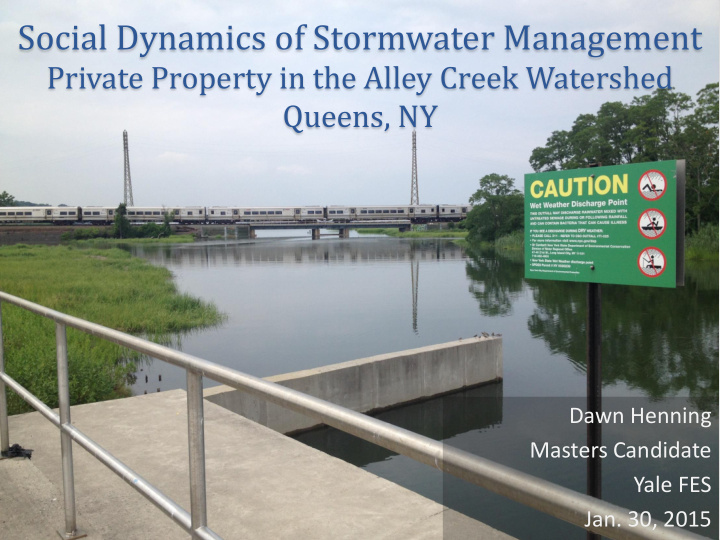



Social Dynamics of Stormwater Management Private Property in the Alley Creek Watershed Queens, NY Dawn Henning Masters Candidate Yale FES Jan. 30, 2015
Agenda • Objectives • Methods • Site Description • Typologies • Outreach and Engagement • Program Evaluation • Conclusions • Future Research
Objectives Examine community perceptions of private property and identify opportunities for and hindrances to stormwater management within the Alley Creek watershed in Queens, NY 1. Social Network Analysis 2. Typology Characterization of Individual Homeowners 3. Suggest Effective Outreach and Engagement Methods 4. Assess Existing and Possible Management Actions Conclusions and Future Research Opportunities
Methods • Participant observation, interviews o Over 50 conversations with representatives from city agencies, civic associations, stewardship organizations, and homeowners o 10 of 20 rain barrel owners • Analysis of public meetings • Use of public reports, 311 data, newspapers
Site Description
Typology Clean Landscapers Driver: Particular aesthetic where nature is controlled and not “messy” Results in: Highly manicured landscapes, removal of existing vegetation, no trees
Typology The Jones Driver: Familiarity, ease of maintenance, fits their particular interests Results in: Lawns, low skill/wage workers to perform maintenance, paving of front yards for parking
Typology The Greens Driver: Aligns with values and what they believe to be good for “the” environment Results in: A number of activities- woodlands, vegetable gardens, reduced/no use of pesticides and fertilizers, native plants
Typology Early Adopters Driver: Water conservation and stormwater management Results in: Disconnected downspouts directed towards vegetated areas, rain barrel installations, tree plantings
Typology Historical Preservers Driver: Deep attachment to neighborhood and sense of place Results in: Preservation of existing homes and associated aesthetic. Designation of historic districts and downzoning of neighborhoods.
Typology Without Control Driver: No direct control over landscape features Results in: Uniformity, low maintenance features
Outreach and Engagement City Agencies Local Politicians Community Boards Civic/Steward Orgs Private Homeowner
City Agencies Local Community Politicians Boards Civic/Steward Orgs Private Homeowner Newspaper/ Media Schools Churches Libraries
Outreach and Engagement • Beyond incentives o Cost not only barrier! o Aesthetics, risk, time, knowledge of techniques as barriers
Outreach and Engagement
Existing Initiatives • • Stewardship Activities Bioswale Implementation • • 2008 Yards Text Amendment Post-development SW Mgmt Ordinance, Atlanta • 2012 Stormwater Performance • Standard Water Audit Program, Baltimore and DC • Rain Barrel Giveaway Program • SW Facility Credit Program, Seattle • NYC GI Grant Program
Recommended Initiatives Impact (biophysical and social) • Area of impervious cover disconnected • Number of homeowners reached by initiative o Goal of even distribution to all populations • Priority to initiatives that promote vegetation over detention Investment • Estimated financial and human resources needed • Feasibility and ease of implementation
Conclusions • Protect existing pervious area • Capitalize on existing social networks and engage new populations • Pilot more GI projects on private property • Increase trust and communication between “public” and the “city”
Future Research • Testing the typology • Controlled studies examining the impact of different outreach and engagement methods • Comparative research with another watershed • Linking typology to a spatially available source • Community mapping project
Thank You! Erika, Lindsay and the UFS Staff • Marit, Vjeko and the Parks Department • Colleen, Gabe and URI • Dana and Uma •
Recommend
More recommend